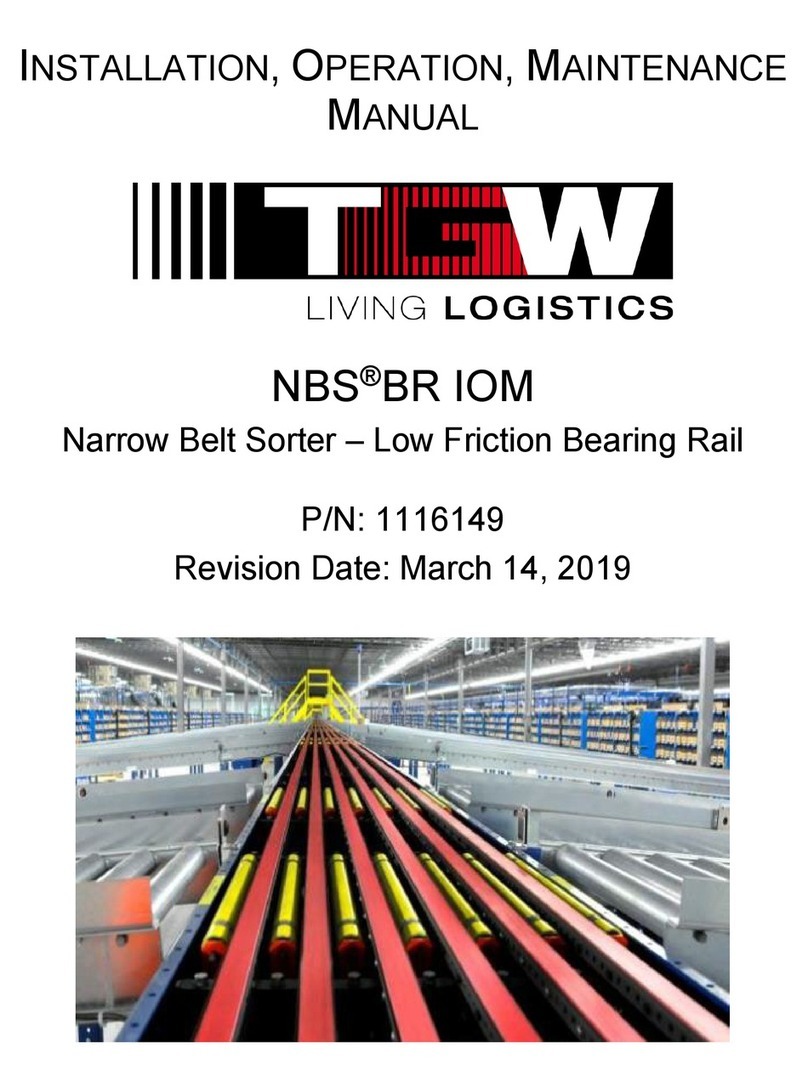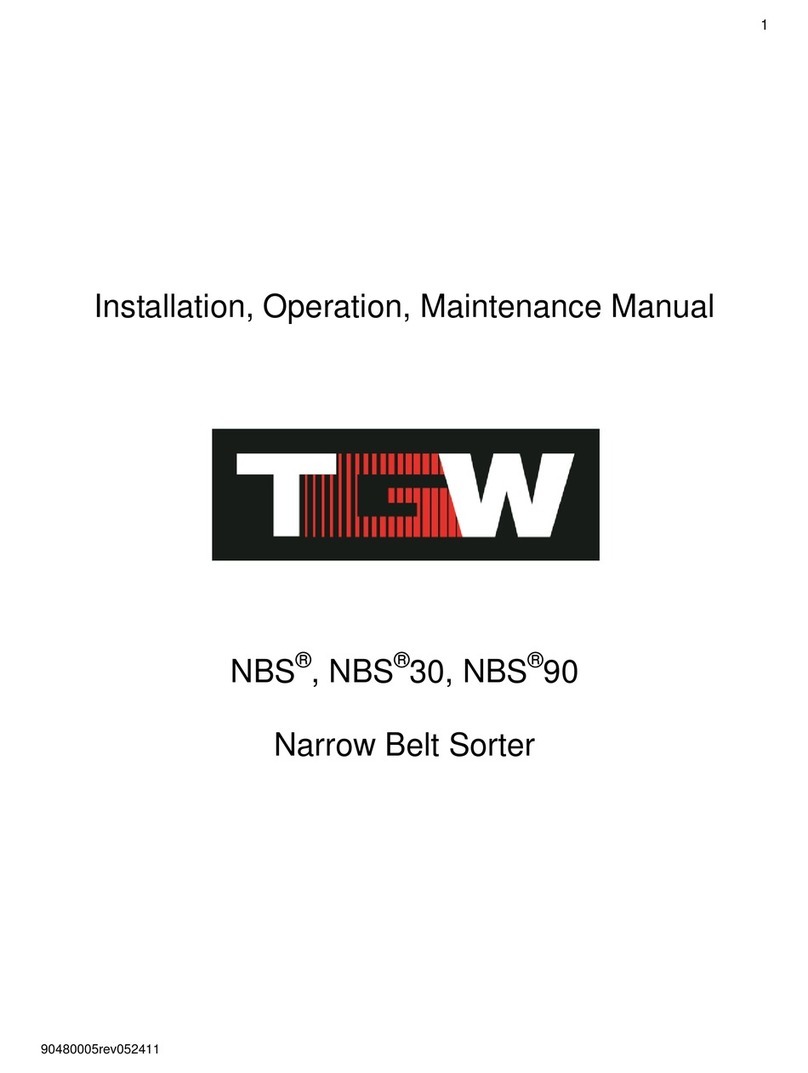TGW NBS 90 SP Instruction manual

Installation, Operation, Maintenance
Manual
NBS®90 SP & NBS®90 PolySort
Narrow Belt Sorter (NBS)
P/N: 1193974
Revision Date: 4/25/2019
NBS90 SP (Small Parcels) NBS90 PolySort

NBS®90 PolySort & SP IOM
P/N: 1193974 Revision Date: 4/25/2019 Page 2of 83
Table of Contents
CHAPTER 1: PURPOSE ...........................................................................................................................................4
CHAPTER 2: EQUIPMENT WARRANTY..................................................................................................................5
CHAPTER 3: WARNINGS & SAFETY INSTRUCTIONS ..........................................................................................6
3.1: TGW SYSTEMS RECOMMENDED STANDARDS FOR CONVEYORS ...........................................................................7
3.2: TGW RECOMMENDS PROPER LABELS FOR CONVEYOR TYPES.............................................................................8
3.3: WARNINGS AND SAFETY INSTRUCTIONS ..............................................................................................................9
3.4: TGW SYSTEMS CONVEYOR CONTROLS SAFETY GUIDELINES............................................................................ 12
3.5: DEFINITION OF TERMS ..................................................................................................................................... 14
CHAPTER 4: NBS®90 POLYSORT APPLICATION GUIDELINES ....................................................................... 17
CHAPTER 5: NBS®90 SP (SMALL PARCELS) SELECTION GUIDELINES....................................................... 20
CHAPTER 6: NBS RECEIVING & SITE PREPARATION...................................................................................... 22
6.1: NBS PARTS INVENTORY &IDENTIFICATION....................................................................................................... 23
CHAPTER 7: NBS PARTS INVENTORY & IDENTIFICATION.............................................................................. 24
CHAPTER 8: NBS INSTALLATION DETAILS ...................................................................................................... 25
8.1: NBS GENERAL ELECTRICAL REQUIREMENTS.................................................................................................... 26
8.2: NBS90 POLYSORT TGW-ERMANCO CONTROLS GUIDELINES........................................................................ 28
8.3: NBS90 SP ELECTRICAL CONTROL ENCLOSURE ............................................................................................... 37
8.4: NBS GEAR MOTOR ACTIVATION ...................................................................................................................... 38
8.5: NBS ELEVATIONS ........................................................................................................................................... 40
8.6: NBS SUPPORTING ARRANGEMENT .................................................................................................................. 40
8.7: NBS SUPPORTS &CONNECTIONS ................................................................................................................... 41
8.8: NBS90 POLYSORT BED CONNECTION KIT......................................................................................................... 42
8.9: NBS90 POLYSORT COMPONENT ORIENTATION................................................................................................ 43
8.10: NBS90 POLYSORT TRANSFER GENERAL LAYOUT .......................................................................................... 44
8.11: NBS90 POLYSORT SENSING SWITCHES ........................................................................................................ 45
8.12: NBS90 SP SORTER TRANSFER GENERAL LAYOUT......................................................................................... 46
8.13: NBS90 POLYSORT CEILING SUPPORTED....................................................................................................... 47
8.14: NBS ALUMINUM EXTRUSION T-NUT CONNECTORS ......................................................................................... 49
8.15: NBS BELT INSTALLATION .............................................................................................................................. 50
8.16: NBS BELT SPECIFICATIONS AND LACING........................................................................................................ 52
CHAPTER 9: NBS PNEUMATIC GENERAL GUIDELINES .................................................................................. 53
9.1: NBS90 POLYSORT PNEUMATIC....................................................................................................................... 54
9.2: NBS90 POLYSORT AIR SUPPLY REQUIREMENTS.............................................................................................. 55
9.3: NBS90 SP AIR SUPPLY REQUIREMENTS ......................................................................................................... 56
9.4: NBS90 SP &POLYSORT AIR LINE CONNECTIONS............................................................................................ 57
9.5: NBS90 SP SOLENOIDS ................................................................................................................................... 58
9.6: NBS AIR REGULATOR LOCK OUT VALVE ON AND OFF POSITION ....................................................................... 59
9.7: NBS COMMISSIONING OF EQUIPMENT.............................................................................................................. 60
CHAPTER 10: NBS MAINTENANCE & TROUBLESHOOTING ........................................................................... 62
10.1: NBS MAINTENANCE CHECKLIST..................................................................................................................... 65
10.2: MAINTENANCE SCHEDULE ............................................................................................................................. 66
10.3: NBS TROUBLESHOOTING GUIDE ................................................................................................................... 68
10.4: NBS REPAIR PROCEDURES........................................................................................................................... 70
CHAPTER 11: PARTS IDENTIFICATION .............................................................................................................. 71
11.1: REPLACEMENT PARTS IDENTIFICATION........................................................................................................... 71

NBS®90 PolySort & SP IOM
P/N: 1193974 Revision Date: 4/25/2019 Page 3of 83
11.2: SPARE PARTS PRIORITY LEVEL EXPLANATIONS .............................................................................................. 71
11.3: NBS90 POLYSORT INTERMEDIATE BED AR W/AIR TAKE-UP 4’0” .................................................................... 72
11.4: NBS90 POLYSORT BELT TAKE-UP ................................................................................................................ 74
11.5: NBS90 POLYSORT END PULLEY AR 4’0” W/AIR TAKE-UP .............................................................................. 75
11.6: NBS90 POLYSORT END PULLEY AR 1’6”....................................................................................................... 77
11.7: NBS90 POLYSORT TRANSFER ASSEMBLY ..................................................................................................... 78
11.8: NBS90 SP &POLYSORT ENCODER ASSEMBLY ............................................................................................. 79
11.9: NBS90 SP TRANSFER ASSEMBLY REPLACEMENT PARTS DIAGRAM ................................................................ 80
11.10: NBS90 SP END PULLEY ASSEMBLY REPLACEMENT PARTS DIAGRAM........................................... 81
WORKS CITED ....................................................................................................................................................... 82
TGW GENERAL INFORMATION ................................................................................................................................ 82
TGW SYSTEMS INFORMATION............................................................................................................................ 83

NBS®90 PolySort & SP IOM
P/N: 1193974 Revision Date: 4/25/2019 Page 4of 83
Chapter 1: PURPOSE
IOM Purpose
It is the intent of TGW Systems, through this
manual, to provide information that acts as a
guide in the installation, operation, and
maintenance of TGW Systems supports and
connections.
This manual describes basic installation
practices, assembly arrangements, preventive
maintenance, and assists in replacement parts
identification.
This service manual is intended for use by
personnel who are knowledgeable of installation
and safe working practices on conveyor systems.
Not all applications and conditions can be
covered; therefore, this manual is to be used
ONLY as a guide.
If additional copies of this manual are needed or
if you have any question concerning the
conveyor please contact your TGW Distributor or
TGW Lifetime Services at 231-798-4547 or visit
TGW at https://www.tgw-conveyor.com/ for
maintenance videos and other application
information.
Manual Structure
You should receive a separate
documentation for each product line of TGW
Systems implemented in your installation. You
can identify the respective product line on the
back of the folder or on the cover sheet of the
IOM (Installation Operation Maintenance Manual)
•Pay attention to the safety
instructions!
•Prior to working at or in the
immediate vicinity of the system it is
recommended that you make
yourself familiar with the safety
instructions included in the present
document!
WARNING

NBS®90 PolySort & SP IOM
P/N: 1193974 Revision Date: 4/25/2019 Page 5of 83
Chapter 2: EQUIPMENT WARRANTY
TGW Systems Equipment Warranty
TGW Systems warrants that the material and workmanship
entering into its equipment is merchantable and will be
furnished in accordance with the specifications stated.
TGW Systems agrees to furnish the purchaser without
charge any part proved defective within 2 years from date of
shipment provided the purchaser gives TGW Systems
immediate notice in writing and examination proves the
claim that such materials or parts were defective when
furnished. For drive components specific to XenoROL
®
(i.e.
Xeno belts, slave Xeno belts, drive spools, standard and
speed-up, and spacers), this warranty shall be extended to
five years of running use, provided the conveyors are
applied, installed and maintained in accordance with TGW
Systems published standards. Other than the above, there
are no warranties which extend beyond the description on
the face hereof. Consequential damages of any sort are
wholly excluded.
The liability of TGW Systems will be limited to the
replacement cost of any defective part. All freight and
installation costs relative to any warranted part will be at the
expense of the purchaser. Any liability of TGW Systems
under the warranties specified above is conditioned upon
the equipment being installed, handled, operated, and
maintained in accordance with the written instructions
provided or approved in writing by TGW Systems.
The warranties specified above do not cover, and TGW
Systems makes no warranties which extend to, damage to
the equipment due to deterioration or wear occasioned by
chemicals, abrasion, corrosion or erosion; Purchaser's
misapplication, abuse, alteration, operation or maintenance;
abnormal conditions of temperature or dirt; or operation of
the equipment above rated capacities or in an otherwise
improper manner.
THERE ARE NO WARRANTIES, EXPRESSED OR
IMPLIED, INCLUDING, BUT NOT LIMITED TO,
WARRANTIES OF MERCHANTABILITY OR FITNESS FOR
A PARTICULAR PURPOSE, EXTENDING BEYOND
THOSE SET FORTH IN THIS STATEMENT OF
WARRA N T Y.
Rev 9/23/2016
TGW Environment Standards
TGW equipment is designed to be installed in a clean,
dry warehouse environment. Exposure to extreme
humidly, direct sunlight, blowing dirt or rain can
permanently damage some components of TGW
conveyor. In particular, the curing agents in concrete
are known to attack and degrade the urethane
conveyor components.
When installing conveyor on a new construction site,
be sure that the concrete is properly cured before
setting conveyor on it. In addition, if conveyors are
stored in the proximity of curing concrete, proper
ventilation must be used to direct the curing agent
fumes away from the conveyor.
Failure to comply with these guidelines will void the
TGW warranty on any failed components that result
from these environment issues.
Other manuals for NBS 90 SP
1
This manual suits for next models
1
Table of contents
Other TGW Accessories manuals























